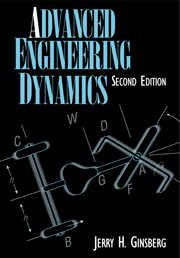Book contents
- Frontmatter
- Contents
- Preface
- Chapter 1 Basic Considerations
- Chapter 2 Particle Kinematics
- Chapter 3 Relative Motion
- Chapter 4 Kinematics of Rigid Bodies
- Chapter 5 Newtonian Kinetics of a Rigid Body
- Chapter 6 Introduction to Analytical Mechanics
- Chapter 7 Further Concepts in Analytical Mechanics
- Chapter 8 Gyroscopic Effects
- Appendix Centroidal Inertia Properties
- Answers to Even-Numbered Problems
- Index
Chapter 2 - Particle Kinematics
Published online by Cambridge University Press: 05 June 2012
- Frontmatter
- Contents
- Preface
- Chapter 1 Basic Considerations
- Chapter 2 Particle Kinematics
- Chapter 3 Relative Motion
- Chapter 4 Kinematics of Rigid Bodies
- Chapter 5 Newtonian Kinetics of a Rigid Body
- Chapter 6 Introduction to Analytical Mechanics
- Chapter 7 Further Concepts in Analytical Mechanics
- Chapter 8 Gyroscopic Effects
- Appendix Centroidal Inertia Properties
- Answers to Even-Numbered Problems
- Index
Summary
This chapter develops some basic techniques for describing the motion of a particle. Each description is based on a different set of coordinates. The set best suited to a particular situation depends on a variety of factors, but a primary consideration is whether the coordinates naturally fit known aspects of the motion. At the end of this chapter, we will examine situations where more than one of these descriptions may be employed beneficially.
Path Variables – Intrinsic Coordinates
The idea that the motion of a point should be described in terms of the properties of its path may not seem to be obvious. However, this is precisely how one thinks when using a road map and the speedometer and odometer of an automobile. This type of description is known as path variables, or less commonly as intrinsic coordinates, because the basic parameters that are considered to change are associated with the properties of the path. The terms tangent and normal components are also used because those are the primary directions, as we shall see. We assume that the path is known. The most fundamental variable for a specified path is the arclength s along this curve, measured from some starting point to the point of interest. As shown in Figure 2.1, measurement of s requires statement of positive sense along the path. Thus, negative s means that the point has receded, rather than advanced, along its path.
- Type
- Chapter
- Information
- Advanced Engineering Dynamics , pp. 13 - 54Publisher: Cambridge University PressPrint publication year: 1995
- 1
- Cited by



